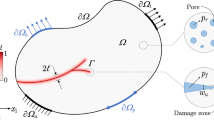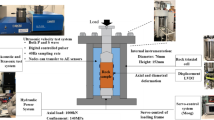Abstract
The work presented herein aims at characterizing and modeling fracturing (i.e., initiation and propagation of cracks) in a clay-rich rock. The analysis is based on two experimental campaigns. The first one relies on a probabilistic analysis of crack initiation considering Brazilian and three-point flexural tests. The second one involves digital image correlation to characterize crack propagation. A nonlocal damage model based on stress regularization is used for the simulations. Two thresholds both based on regularized stress fields are considered. They are determined from the experimental campaigns performed on Lower Watrous rock. The results obtained with the proposed approach are favorably compared with the experimental results.











Similar content being viewed by others
Abbreviations
- \({\varvec{\sigma }}\) :
-
Stress tensor
- \(\overline{{\varvec{\sigma }}}\) :
-
Regularized stress tensor
- \(\ell _{\mathrm{c}}\) :
-
Characteristic length
- \({\varDelta }\) :
-
Laplacian operator
- \({\varvec{n}}\) :
-
Normal to surface
- \(P_{\mathrm{i}}\) :
-
Crack initiation probability
- \(S_{\mathrm{i}}\) :
-
Crack initiation stress
- \(\frac{\sigma _{0}^{m}}{\lambda _{0}}\) :
-
Scale parameter
- \(V_{\mathrm{el}}\) :
-
Volume of an element
- m :
-
Weibull modulus
- \(\sigma _{\ell _{\mathrm{c}}}\) :
-
Nominal stress
- \(S_{\mathrm{g}}\) :
-
Crack growth stress
- \(K_{\mathrm{c}}\) :
-
Fracture toughness
- \({\varGamma }\) :
-
Gamma function
- \(\rho\) :
-
Mass density
- d :
-
Damage
- \(\psi _{\mathrm{e}}\) :
-
State potential
- \({\mathcal {C}}\) :
-
Hooke’s tensor
- \({\varvec{\epsilon }}\) :
-
Infinitesimal strain tensor
- Y :
-
Thermodynamic force associated with damage
- \(H_{\mathrm{e}}\) :
-
Heaviside function
- \({\overline{\sigma }}_{\mathrm{I}}\) :
-
Maximum principal regularized stress
- a :
-
Half-length of critical defect
- \(\sigma _{\mathrm{w}}\) :
-
Weibull stress
- \(\sigma _{\mathrm{w}i}\) :
-
Weibull stress associated with sample i
- \(P_{\mathrm{F}}\) :
-
Failure probability
- \(P_{\mathrm{F}i}\) :
-
Failure probability associated with sample i
- \(\sigma_{\mathrm{f}}\) :
-
Critical maximum principal stress
- H :
-
Stress heterogeneity factor
- V :
-
Sample volume
- \(H_{\mathrm{br}}\) :
-
Stress heterogeneity factor for Brazilian test
- \(V_{\mathrm{br}}\) :
-
Sample volume for Brazilian test
- \(H_{\mathrm{fl}}\) :
-
Stress heterogeneity factor for three-point flexural test
- \(V_{\mathrm{fl}}\) :
-
Sample volume for three-point flexural test
- \(n_{\mathrm{s}}\) :
-
Total number of samples
- R :
-
Radius of Brazilian test sample
- L :
-
Length of Brazilian test sample
- \(K_{\mathrm{I}}\) :
-
Mode I stress intensity factor
- \(K_{\mathrm{II}}\) :
-
Mode II stress intensity factor
- \(r_{\mathrm{K}}\) :
-
Ratio between mode II and mode I stress intensity factors
References
Baecher GB, Einstein HH (1981) Scale effect in rock testing. Geophys Res Let 8:671–674
Baghbanan A, Lanru J (2007) Hydraulic properties of fractured masses with correlated fracture length and aperture. Int J R Mech Min Sci 44:704–719
Bažant Z, Belytschko TB (1985) Wave propagation in strain-softening bar: exact solution. J Eng Mech 111:381–389
Bažant ZP, Pijaudier-Cabot G (1988) Nonlocal continuum damage, localization instability and convergence. J Appl Mech 55:521–539
Beremin FM (1983) A local criterion for cleavage fracture of a nuclear pressure vessel steel. Metall Trans 14:2277–2287
Besnard G, Hild F, Roux S (2006) “Finite-element” displacement fields analysis from digital images: application to Portevin-Le Chatelier bands. Exp Mech 46:789–804
Bush AJ (1976) Experimentally determined stress-intensity factors for single-edge-crack round bars in bending. Exp Mech 16:249–257
Code_Aster (2010). EDF R&D. http://www.code-aster.org. Accessed 1 June 2010
Da Silva ACR, Proença SPB, Billardon R, Hild F (2004) Probabilistic approach to predict cracking in lightly reinforced microconcrete panels. J Eng Mech 130:931–941
De Borst R, Sluys LJ, Muhlaus HB, Pamin J (1993) Fundamental issues in finite element analysis of localization of deformation. Eng Comput 10:99–121
Forquin P, Rota L, Charles Y, Hild F (2004) A method to determine the macroscopic toughness scatter of brittle materials. Eur J Mech A Solids 125:171–187
Funatsu T, Seto M, Shimada H, Matsui K, Kuruppu M (2004) Combined effects of increasing temperature and confining pressure on the fracture toughness of clay bearing rocks. Int J R Mech Min Sci 41:927–938
Gosh A (1999) A FORTRAN program for fitting Weibull distribution and generating samples. Comput Geosci 25:729–738
Guy N (2010) Modélisation probabiliste de l’endommagement des roches : application au stockage géologique du \({\text{CO}}_2\). Ph.D. thesis, Ecole Normale Supérieure de Cachan
Guy N, Seyedi D, Hild F (2010) Hydro-mechanical modelling of geological CO\(_{2}\) storage and the study of possible caprock fracture mechanisms. Georisk 4:110–117
Guy N, Seyedi D, Hild F (2012) A probabilistic nonlocal model for crack initiation and propagation in heterogeneous brittle materials. Int J Numer Methods Eng 90:1053–1072
Hild F, Roux S (2006) Digital image correlation: from displacement measurement to identification of elastic properties—a review. Strain 42:69–80
Jobmann M, Wilsnack T, Voigt HD (2010) Investigation of damage induced permeability of Opalinus clay. Int J R Mech Min Sci 47:279–285
Kanninen MF, Brust FW, Ahmad J, Abou-Sayed IS (1982) The numerical simulation of crack growth in weld-induced residual stress fields. In: Kula E, Weiss V (eds) Residual stress and stress relaxation. Plenum Press, New York, pp 975–986
Lasry D, Belytschko T (1988) Localization limiters in transient problems. Int J Solids Struct 24:581–597
Lawn BR (1993) Fracture of brittle material. Cambridge University Press, Cambridge
Le Nindre YM, Gauss I (2004) Characterisation of the lower watrous aquitard as major seal for \({\text{ CO }}_2\) geological sequestration. In: 7th International Conference on Greenhouse Gas Control Technologies, Vancouver, Canada, 5–9 Sept
Lorentz E, Benallal A (2005) Gradient constitutive relations: numerical aspects and application to gradient damage. Comput Methods Appl Mech Eng 194:5191–5220
Lyakhovsky V, Hamiel Y, Ben-Zion Y (2011) A non-local visco-elastic damage model and dynamic fracturing. J Mech Phys Solids 59:1752–1776
Murakami Y (1987) Stress intensity factors handbook. Pergamon Press, Oxford
Nose T, Fuji T (1988) Evaluation of fracture toughness for ceramics materials by a single-edge-precracked-beam method. J Am Ceram Soc 71:328–333
Ouchterlony F (1988) ISRM commission on testing methods; suggested methods for determining fracture toughness of rock. Int J R Mech Min Sci 25:71–96
Pancheri P, Bosetti P, Dal Maschio R, Sglavo VM (1998) Production of sharp cracks in ceramic materials by three-point bending of sandwiched specimens. Eng Frac Mech 59:447–456
Peerlings RHJ, de Borst R, Brekelmans WAM, Geers MGD (1998) Gradient-enhanced damage modelling of concrete fracture. Mech Cohes Frict Mater 3:323–342
Peerlings RHJ, Geers MGD, de Borst R, Brekelmans WAM (2001) A critical comparison of non-local and gradient-enhanced softening continua. Int J Solids Struct 38:7723–7746
Pietruszczak S, Mróz Z (1981) Finite element analysis of deformation of strain-softening materials. Int J Numer Methods Eng 17:327–334
Pijaudier-Cabot G, Bažant ZP (1987) Nonlocal damage theory. J Eng Mech 113:1512–1533
Preston C, Monea M, Jazrawi W, Brown K, Whittaker S, White D, Law D, Chalaturnyk R, Rostron B (2005) IEA GHG Weyburn \({\text{ CO }}_2\) monitoring and storage project. Fuel Process Technol 86:1547–1568
Roux S, Hild F (2006) Stress intensity factor measurements from digital image correlation: post-processing and integrated approaches. Int J Fract 140:141–157
Srawley JE (1976) Wide range stress intensity factor expressions for ASTM E399 standard fracture toughness specimens. Int J Frac 12:475–476
Sutton MA, Orteu JJ, Schreier H (2009) Image correlation for shape, motion and deformation measurements: basic concepts, theory and applications. Springer, New York
Triantafyllidis N, Aifantis EC (1986) A gradient approach to localization of deformation: I. Hyperelastic materials. J Elast 16:225–237
Weibull W (1939) A statistical theory of the strength of materials. Generalstabens Litografiska Anstalts Förlag, Stockholm
Wu D, Zhou J, Li Y (2006) Unbiased estimation of Weibull parameters with the linear regression method. J Eur Ceram Soc 26:1099–1105
Zuo JP, He-Ping X, Feng D, Yang J (2014) Three point bending test investigation of the fracture behavior of siltstone after thermal treatment. Int J R Mech Min Sci 70:133–143
Acknowledgements
This work was funded by BRGM through an “Institut Carnot” research Grant. The authors wish to thank Dr. Steve Whittaker and Saskatchewan Industry and Resource for kindly providing the samples of Lower Watrous caprock.
Author information
Authors and Affiliations
Corresponding author
Rights and permissions
About this article
Cite this article
Guy, N., Seyedi, D.M. & Hild, F. Characterizing Fracturing of Clay-Rich Lower Watrous Rock: From Laboratory Experiments to Nonlocal Damage-Based Simulations. Rock Mech Rock Eng 51, 1777–1787 (2018). https://doi.org/10.1007/s00603-018-1432-2
Received:
Accepted:
Published:
Issue Date:
DOI: https://doi.org/10.1007/s00603-018-1432-2




